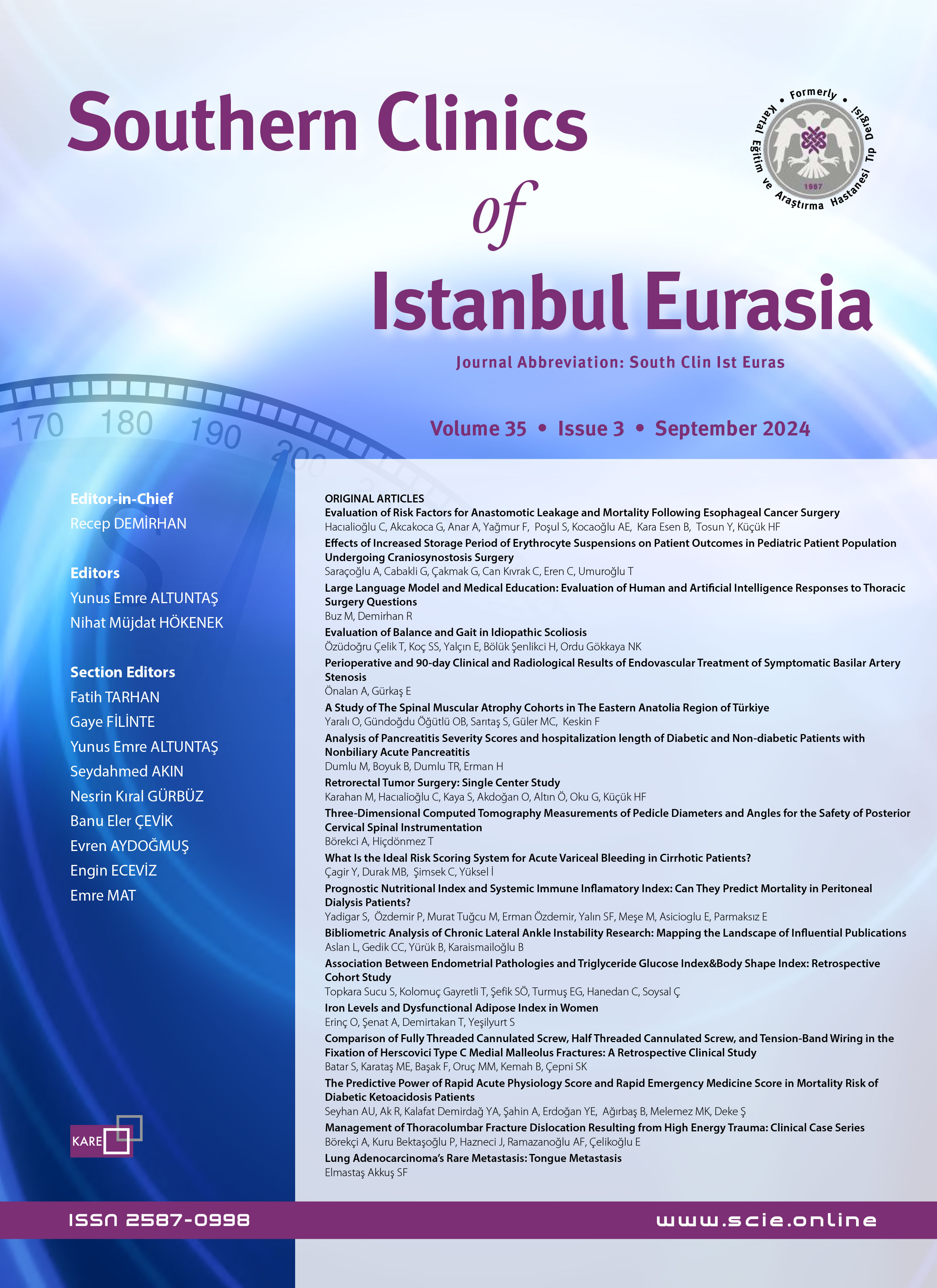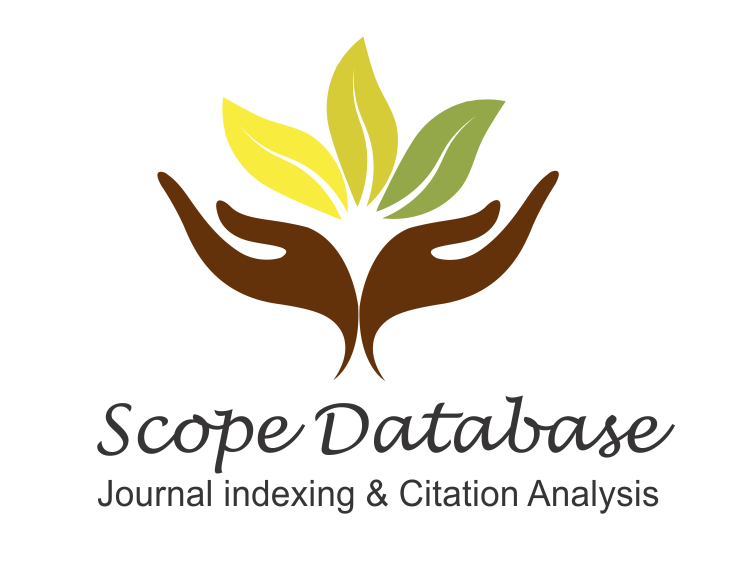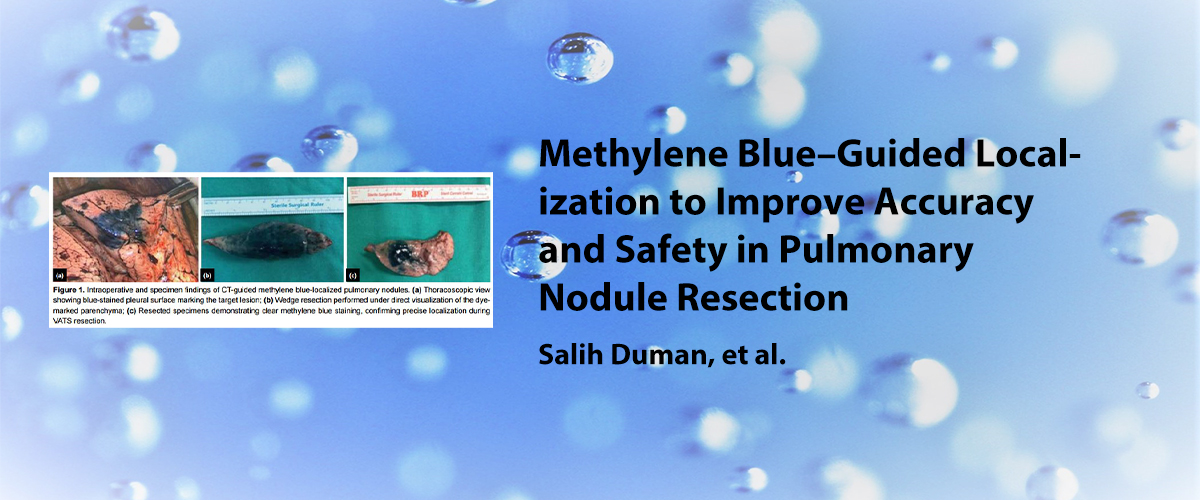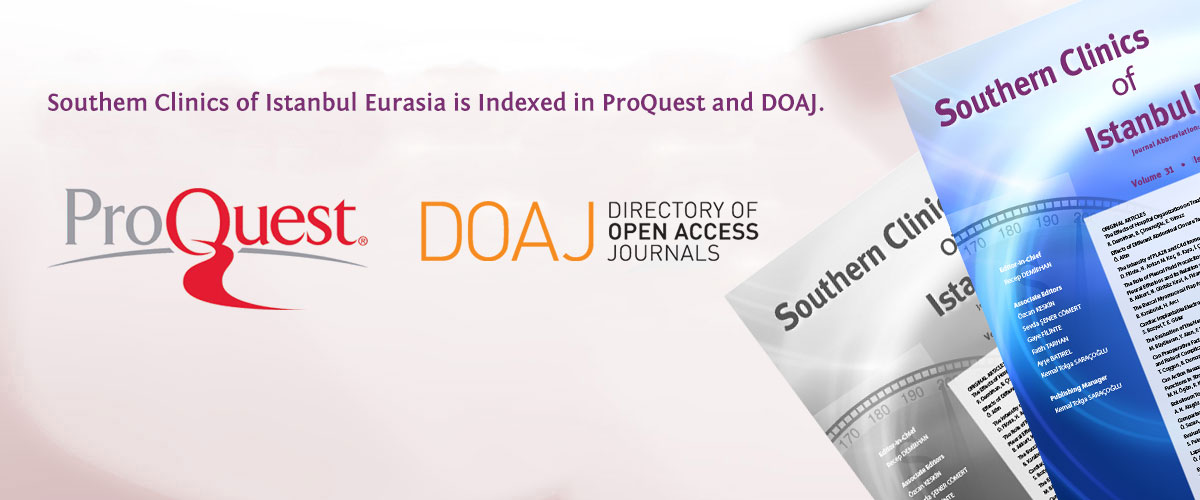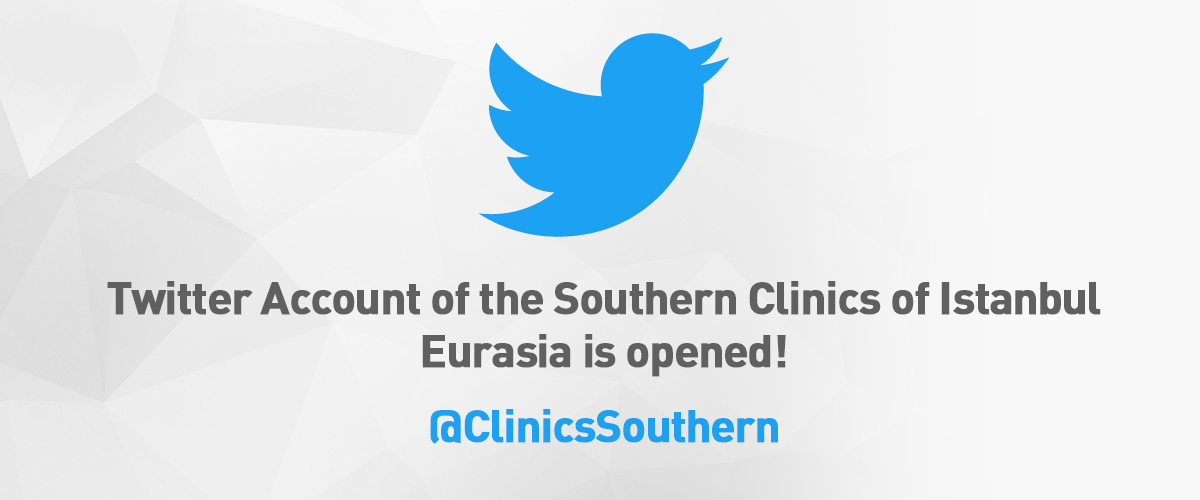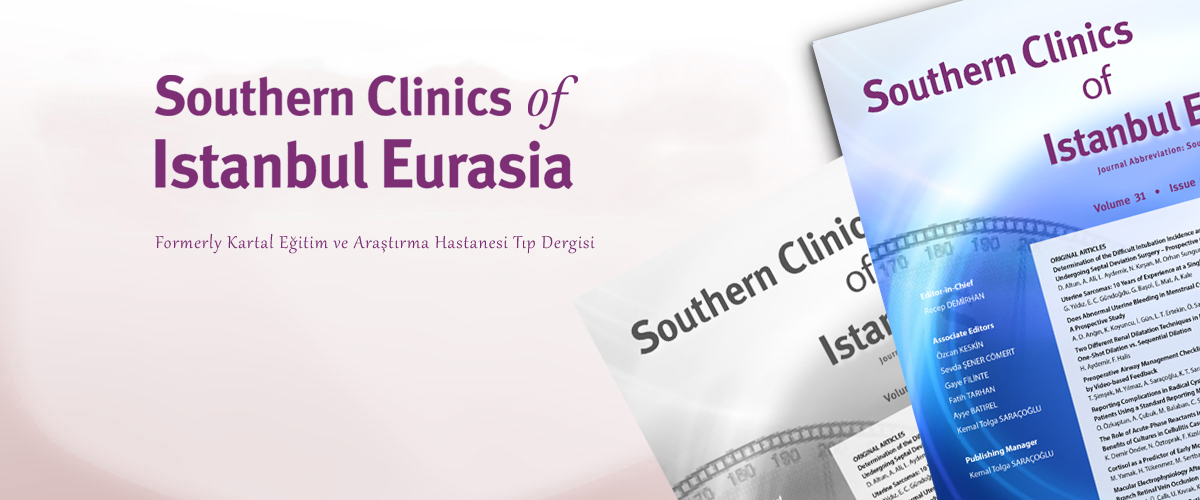Instructions For Authors
About the Journal
Southern Clinics of Istanbul Eurasia - SCIE (formerly Kartal Eğitim ve Araştırma Hastanesi Tıp Dergisi - The Medical Journal of Kartal Training and Research Hospital)
is published four issue in English by the Kartal Dr. Lütfi Kırdar Training and Research Hospital, and is a peer reviewed general medical journal for all physicians,
doctors, medical researchers, and health workers. The journal reports the advances and progress in current medical sciences and technology. The journal covers basic
and clinical studies in medicine. Articles of clinical interest and implications will be given preference.
Contributions may be in the form of clinical and basic research articles, case reports, personal clinical and technical notes, and letters to the Editor. The Journal also publishes brief reports on original studies or evaluations, book reviews, and proceedings of scientific meetings. The Editor-in-Chief may request from the authors additional data, information, or complementary material concerning the manuscripts, and the authors must comply with such requests.
Manuscripts should be prepared in accordance with the Uniform Requirements for Manuscripts Submitted to Biomedical Journals regularly updated by the International Committee of Medical Journal Editors, available at www.icmje.org
Ethics
The editorial and publication processes of the journal are shaped in accordance with the guidelines of the International Council of Medical Journal Editors (ICMJE),
the World Association of Medical Editors (WAME), the Council of Science Editors (CSE), the Committee on Publication Ethics (COPE), the European Association of
Science Editors (EASE), and National Information Standards Organization (NISO).
An approval of research protocols by the Ethics Committee in accordance with international agreements (World Medical Association Declaration of Helsinki Ethical Principles for Medical Research Involving Human Subjects, amended in October 2013, www.wma.net) is required for experimental, clinical, and drug studies and for some case reports. If required, ethics committee reports or an equivalent official document will be requested from the authors.
All manuscripts presenting data obtained from research involving human subjects must include a statement that the written informed consent of the participants was obtained and that the study was approved by an institutional review board or an equivalent body. This institutional approval should be submitted with the manuscript. Authors of case reports must submit the written informed consent of the subject(s) of the report or of the patients legal representatives for the publication of the manuscript.
All studies should be carried out in accordance with the World Medical Association Declaration of Helsinki, covering the latest revision date. Patient confidentiality must be protected according to the universally accepted guidelines and rules. Manuscripts reporting the results of experimental studies on animals must include a statement that the study protocol was approved by the animal ethics committee of the institution and that the study was conducted in accordance with the internationally accepted guidelines, including the Universal Declaration of Animal Rights, European Convention for the Protection of Vertebrate Animals Used for Experimental and Other Scientific Purposes, Principles of Laboratory Animal Science, and the Handbook for the Care and Utilization of Laboratory Animals. The authors are strongly requested to send the approval of the ethics committee together with the manuscript. In addition, manuscripts on human and animal studies should describe procedures indicating the steps taken to eliminate pain and suffering.
Submission and Peer Review
The official language of the Journal is English. Articles may submitted only in English.
A technical review is performed to confirm that all of the required documentation has been submitted and to conduct a preliminary evaluation of
the manuscript and supplementary files to assess suitability for the Journal. The manuscript will be returned to the Author in the event of any deficiency.
The Editorial Office of SCIE then assigns the manuscript a number and begins the peer preview process. This journal operates a blind review process. Contributions deemed suitable are then typically sent to a minimum of two independent expert reviewers in the field of study to assess the scientific quality of the paper. The Editor is responsible for the final decision regarding acceptance or rejection of articles. The Editor's decision is final.
Copyright - Authors approval - Conflict of interest
The authors should disclose all issues concerning financial relationship, conflict of interest, and competing interest that may potentially influence
the results of the research or scientific judgement. All financial contributions or sponsorship, financial relations, and areas of conflict of interest
should be clearly explained in a separate letter to the editor at the time of submission, with full assurance that any related document will be submitted
to the Journal when requested.
Manuscripts should be sent with the Copyright-Authors Approval-Conflict of Interest Letter signed by the author(s). A copy of this letter can be found at web site. Manuscripts will not be accepted for evaluation until the receipt of this document by the Journal.
All submissions are screened with similarity detection software (iThenticate by Turnitin).
In the event of alleged or suspected research misconduct, e.g., plagiarism, citation manipulation, or data falsification/fabrication, the Editorial Board will follow up and act in accordance with COPE guidelines.
Copyright Notice
All published material will become the sole property and will be copyrighted by the Journal.
Articles and illustrations become the property of the Journal after publication.
Open Access and Commons User Licenses
Open Access
The SCIE is an open access journal which means that all content is freely available without charge to the user or his/her institution.
Users are allowed to read, download, copy, distribute, print, search, or link to the full texts of the articles, or use them for any other
lawful purpose, without asking prior permission from the publisher or the author. This is in accordance with the BOAI definition of open access.
Commons User Licenses
This work is licensed under a
Creative Commons Attribution-Non Commercial 4.0 International License (CC BY-NC 4.0) .
Submitting a Manuscript
SCIE accepts only on-line submission via the official web site (please click, http://www.scie.online/en/?s=online_submission) and refuses
printed manuscript submissions by mail. All submissions are made by the on-line submission system called Journal Agent, by clicking the icon
Online manuscript submission at the above mentioned web site homepage. The system includes directions at each step but for further information you may visit the web site.
Correction and Retraction of Articles
Corrections may be made to a published article with the authorization of the editor of the journal.
Editors will decide the magnitude of the corrections. Minor corrections are made directly to the original article.
However, in cases of major corrections, the original article will remain unchanged, while the corrected version will
also be published and linked to the corrected version. A statement indicating the reason for the major change to the
article will also be published. When necessary, retraction of articles will be done according to the Committee on Publication Ethics (COPE) retraction guidelines.
https://publicationethics.org/resources/guidelines
Important Notice
Before the corresponding author submits the manuscript, all authors must obtain ORCİD
ID number and provide it to the corresponding author.
Manuscript Preparation
The author(s) must declare that they were involved in at least 3 of the 5 stages of the study stated in the acknowledgement of authorship and transfer of copyright agreement
as designing the study, collecting the data, analyzing the data, writing the manuscript and confirming the accuracy of the data and the analyses.
Those who do not fulfill this prerequisite should not be stated as an author.
In multi-center or multi-discipline studies, each authors contribution regarding the 5 stages mentioned above should be stated clearly. For this kind of multi-center or multi-discipline studies with excessive number of authors, the editor has the right to request that the number of authors be reduced.
Manuscripts should be designed in the following order: title page, abstract, main text, references, and tables, with each typeset on a separate page.
Title page: This page should only include the title of the manuscript, which should be carefully chosen to better reflect the contents of the study. Author names should not appear in the title and subsequent pages.
Abstract: It should not exceed 300 words. Abstracts should be structured in four paragraphs using the following subtitles: Objectives, Methods, Results, and Conclusion. Abstracts of case reports should be unstructured.
Main text: The body consists of Introduction, Patients/Materials and methods, Results, and Discussion. Use “Patients and methods” for clinical studies, and “Materials and methods” for animal and laboratory studies.
The Introduction section clearly states the purpose of the manuscript and includes a brief summary of the most relevant literature.
The Patients/Materials and Methods section describes the study population and the study design, with adequate information on the techniques, materials, and methods used. A clear description of the statistical methods should also be given.
The Results section should provide a detailed report on the findings of the study. Data should be concisely presented, preferably in tables or illustrations, which should not exceed the page layout of the Journal.
The Discussion section should mainly rely on the conclusions derived from the results of the study, with relevant citations from the most recent research.
Manuscript Types
Original Articles: This is the most important type of article since it provides new information based on original research. The main text of original articles should be structured with Introduction, Methods, Results, Discussion, and Conclusion subheadings. Original articles are limited to 3500 words and 30 references.
Statistical analysis to support conclusions is usually necessary. Statistical analyses must be conducted in accordance with international statistical reporting standards (Altman DG, Gore SM, Gardner MJ, Pocock SJ. Statistical guidelines for contributors to medical journals. Br Med J 1983: 7; 1489-93). Information on statistical analyses should be provided with a separate subheading under the Materials and Methods section and the statistical software that was used during the process must be specified.
Units should be prepared in accordance with the International System of Units (SI).
Brief Reports: Brief reports convey a focused message. Case series are also considered as Brief Reports. Brief reports are restricted to a maximum of 1500 words; no more than 1 tables and 3 figures; and 10-12 references. They should contain an unstructured abstract up to 150 words and structured text as Introduction, Methods, Results, and Discussion.
Review Articles: Reviews prepared by authors who have extensive knowledge of a particular field and whose scientific background has been translated into a large volume of publications with a high citation potential are welcomed. Submissions from such authors may also be invited by the journal. Reviews should describe, discuss, and evaluate the current level of knowledge of a topic in clinical practice and should guide future studies. The main text should include an Introduction, Clinical and Research Consequences, and Conclusion sections. The abstract is unstructured format with maximum 250 words. The word limit for text is 4000 excluding references. The maximum number of references is 40.
Case Reports: There is limited space for case reports in the journal and reports on rare cases or conditions that constitute challenges in diagnosis and treatment, those offering new therapies or revealing knowledge not included in the literature, and interesting and educative case reports are accepted for publication. Abstract limits with 150 words. The report is limited with 1200 words and 10 references.
Letters to the Editor: This type of manuscript discusses important parts, overlooked aspects, or lacking parts of a previously published article. Articles on subjects within the scope of the journal that might attract the readers attention, particularly educative cases, may also be submitted in the form of a Letter to the Editor. Readers can also present their comments on the published manuscripts in the form of a Letter to the Editor. Abstract, Keywords, and Tables, Figures, Images, and other media should not be included. The text should be unstructured. The manuscript that is being commented on must be properly cited within this manuscript. The limit of words and references is 500 and 5 consecutively.
Table 1. Limitations for each manuscript type
| Type of manuscript |
Word limit |
Abstract word limit |
Reference limit |
Table limit |
Figure limit |
| Original Article |
3500 | 250 (Structured) | 30 | 6 | 6 |
| Brief report | 1500 | 150 | 12 | 1 | 3 |
| Review | 4000 | 250 (Structured) | 40 | 6 | 6 |
| Case report | 1200 | 150 (Structured) | 10 | 1 | 3 |
| Letter to the editor | 550 | No abstract | 5 | No table | No figure |
References: References should be numbered in the order in which they are mentioned in the text. Only published articles or articles in press can be used in references. Unpublished data or personal communications should not be used. The style should conform to the standards described in detail in Citing Medicine-The NLM Style Guide for Authors, Editors, and Publishers (http://www.nlm.nih.gov/citingmedicine), which is recommended in the most recent update of Uniform Requirements for Manuscripts Submitted to Biomedical Journals. A brief presentation of these standards can also be found at http://www.nlm.nih.gov/bsd/uniform_requirements.html. Journal titles should be abbreviated according to the Index Medicus. The Journals title is abbreviated as South Clin Ist Euras.
The style and punctuation should follow the formats outlined below:
Standard journal article:
Napolitano LM, Corwin HL. Efficacy of red blood cell transfusion in the critically ill. Crit Care Clin 2004;20:255-68.
All authors if six or fewer should be listed; otherwise, the first six and et al. should be written.
Epub ahead of print Articles:
Rupprecht H, Heppner HJ, Wohlfart K, Türkoglu A. The geriatric polytrauma: Risk profile and prognostic factors. Ulus Travma Acil Cerrahi Derg 2017 Jan 05. doi: 10.5505/tjtes.2016.77177. [Epub ahead of print].
Personal author(s):
Enzingerz FM, Weiss SW. Soft tissue tumors. St. Louis: Mosby; 1995. p. 27-50.
Editor(s), compiler(s) as author:
Günal I, Barton NJ, Çalli I, editors. Current management of scaphoid fractures. Twenty questions answered. London: The Royal Society of Medicine Press; 2002.
Chapter in a book:
Henick DK, Kennedy DW. Fungal sinusitis. In: Stankiewicz JA, editor. Advanced endoscopic sinus surgery. St Louis: Mosby; 1995. p. 69-80.
Conference paper:
Kouzelis A, Matzaroglou C, Kravvas A, Mylonas S, Megas P, Gliatis J. Anterior cruciate ligament reconstruction: patellar tendon autogaft versus four strand hamstring tendon. In: Proceedings of the 9th Turkish Sports Traumatology, Arthroscopy and Knee Surgery Congress; 2008 Oct 14-18; Istanbul, Türkiye. p. 223. Unpublished conference papers should not be used in the reference list.
Direct use of references is strongly recommended and the authors may be asked to provide the first and last pages of certain references. Publication of the manuscript will be suspended until this request is fulfilled by the author(s).
Figures and tables
All illustrations (photographs, graphics, and drawings) accompanying the manuscript should be referred to as figure. All figures should be numbered consecutively and mentioned in the text. Figure legends should be added at the end of the text as a separate section. Each figure should be prepared as a separate digital file in jpeg format, with a minimum of 9×13 cm and at 300 dpi or better resolution.
All illustrations should be original. Illustrations published elsewhere should be submitted with the written permission of the original copyright holder.
For recognizable photographs of human subjects, written permission signed by the patient or his/her legal representative should be submitted; otherwise, patient names or eyes must be blocked out to prevent identification. Microscopic photographs should include information on staining and magnification.
Upon the authors request, color prints will be considered for publication; however, the authors are responsible for the extra cost of printing color illustrations. Each table should be prepared on a separate page, either at the end of the text file or as a separate supplementary file, with table heading on top of the table. Table heading should be added to the main text file on a separate page when a table is submitted as a supplementary file.
Letter to the Editor: Letters to the editor should not exceed 350 words.
References: References should be numbered in the order in which they are mentioned in the text. Only published articles or articles in press can be used in references. Unpublished data or personal communications should not be used. The style should conform to the standards described in detail in “Citing Medicine-The NLM Style Guide for Authors, Editors, and Publishers” (http://www.nlm.nih.gov/citingmedicine), which is recommended in the most recent update of “Uniform Requirements for Manuscripts Submitted to Biomedical Journals”. A brief presentation of these standards can also be found at http://www.nlm.nih.gov/bsd/uniform_requirements.html. Journal titles should be abbreviated according to the Index Medicus. The Journal’s title is abbreviated as “South Clin Ist Euras”.
The style and punctuation should follow the formats outlined below:
Standard journal article:
Napolitano LM, Corwin HL. Efficacy of red blood cell transfusion in the critically ill. Crit Care Clin 2004;20:255-68.
All authors if six or fewer should be listed; otherwise, the first six and “et al.” should be written.
Epub ahead of print Articles:
Rupprecht H, Heppner HJ, Wohlfart K, Türkoglu A. The geriatric polytrauma: Risk profile and prognostic factors. Ulus Travma Acil Cerrahi Derg 2017 Jan 05. doi: 10.5505/tjtes.2016.77177. [Epub ahead of print].
Personal author(s):
Enzingerz FM, Weiss SW. Soft tissue tumors. St. Louis: Mosby; 1995. p. 27-50.
Editor(s), compiler(s) as author:
Günal İ, Barton NJ, Çallı İ, editors. Current management of scaphoid fractures. Twenty questions answered. London: The Royal Society of Medicine Press; 2002.
Chapter in a book:
Henick DK, Kennedy DW. Fungal sinusitis. In: Stankiewicz JA, editor. Advanced endoscopic sinus surgery. St Louis: Mosby; 1995. p. 69-80.
Conference paper:
Kouzelis A, Matzaroglou C, Kravvas A, Mylonas S, Megas P, Gliatis J. Anterior cruciate ligament reconstruction: patellar tendon autogaft versus four strand hamstring tendon. In: Proceedings of the 9th Turkish Sports Traumatology, Arthroscopy and Knee Surgery Congress; 2008 Oct 14-18; İstanbul, Türkiye. p. 223. Unpublished conference papers should not be used in the reference list.
Direct use of references is strongly recommended and the authors may be asked to provide the first and last pages of certain references. Publication of the manuscript will be suspended until this request is fulfilled by the author(s).
Figures and tables
All illustrations (photographs, graphics, and drawings) accompanying the manuscript should be referred to as “figure”. All figures should be numbered consecutively and mentioned in the text. Figure legends should be added at the end of the text as a separate section. Each figure should be prepared as a separate digital file in “jpeg” format, with a minimum of 9×13 cm and at 300 dpi or better resolution.
All illustrations should be original. Illustrations published elsewhere should be submitted with the written permission of the original copyright holder.
For recognizable photographs of human subjects, written permission signed by the patient or his/her legal representative should be submitted; otherwise, patient names or eyes must be blocked out to prevent identification. Microscopic photographs should include information on staining and magnification.
Upon the author’s request, color prints will be considered for publication; however, the authors are responsible for the extra cost of printing color illustrations. Each table should be prepared on a separate page, either at the end of the text file or as a separate supplementary file, with table heading on top of the table. Table heading should be added to the main text file on a separate page when a table is submitted as a supplementary file.
Checklist
Cover letter
Signed by all contributors
Previous publication / presentations mentioned
Source of funding mentioned
Conflicts of interest disclosed
ORCİD ID number of all contributors
Authors
Last name and given name provided along with Middle name initials (where applicable)
Author for correspondence, with e-mail address provided
Number of contributors restricted as per the instructions
Identity not revealed in paper except title page (e.g. name of the institute in Methods, citing previous study as ‘our study’, names on figure labels, name of institute in photographs, etc.)
Presentation and format
Double spacing
Margins 2 cm from all four sides
Page numbers included at bottom
Title page contains all the desired information
Abstract page contains the full title of the manuscript
Abstract provided (structured abstract of 300 words for original articles, meta analysis (Backgroud, Methods, Results, Conclusions) and review articles (Objective, Data sources, Study selection, Results, Conclusions)
Key words provided (three or no more than 6 words) Introduction should be short and arresting. State the purpose of the article and summarize the rationale for the study or observation. Give only strictly pertinent references
The references cited in the text should be after punctuation marks
References according to the journal’s instructions, punctuation marks checked
Language and grammar
Uniformly American English
Write the full term for each abbreviation at its first use in the title, abstract, keywords and text separately unless it is a standard unit of measure. Numerals from 1 to 10 spelt out
Numerals at the beginning of the sentence spelt out
Check the manuscript for spelling, grammar and punctuation errors
If a brand name is cited, supply the manufacturer’s name and address (city and state/country).
Species names should be in italics
Tables and figures
No repetition of data in tables and graphs and in text
Actual numbers from which graphs drawn, provided
Figures necessary and of high quality (colour)
Table and figure numbers in Arabic letters (not Roman)
Labels pasted on back of the photographs (no names written)
Patients’ privacy maintained (if not permission taken)
Credit note for borrowed figures/tables provided
Write the full term for each abbreviation used in the table as a footnote
| Editor(s)-in-Chief: | Recep DEMIRHAN, Yunus Emre ALTUNTAS, Nihat Mujdat HOKENEK |
| Address: | Kartal Dr. Lutfi Kirdar Egitim ve Arastirma Hastanesi, Denizer Cad. No: 1 34865, Cevizli, Istanbul, Turkiye |
| Phone 1: | 0 216 441 39 00 ( 23 311 ) |
| Phone 2: | 0 216 458 30 00 ( 23 311 ) |
| Web: | www.scie.online |
| E-mail: | [email protected] |
| Publisher: | Istanbul: Kartal Dr. Lutfi Kirdar Kartal Egitim ve Arastirma Hastanesi |
| Address: | Kartal Dr. Lutfi Kirdar Egitim ve Arastirma Hastanesi, Denizer Cad. No: 1 34865, Cevizli, Istanbul, Turkiye |
| Web: | https://lutfikirdareah.saglik.gov.tr/?_Dil=1 |
| Fax: | +90-216-550 61 12 |
| E-mail: | [email protected] |
| Corporate Contributor (Publishing House): | Kare Publishing (Kare Yayıncılık) |
| Address: | Goztepe Mah. Fahrettin Kerim Gokay Cad. No: 200, Da: 2, Goztepe, Kadikoy, Istanbul, Turkiye |
| Phone: | +90-216-550 61 11 |
| Web: | www.karepb.com |
| E-mail: | [email protected] |


